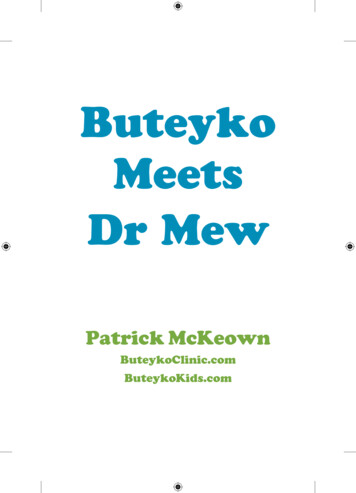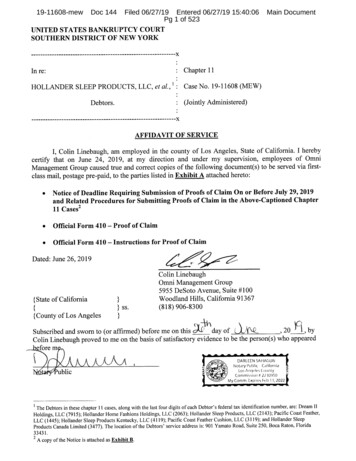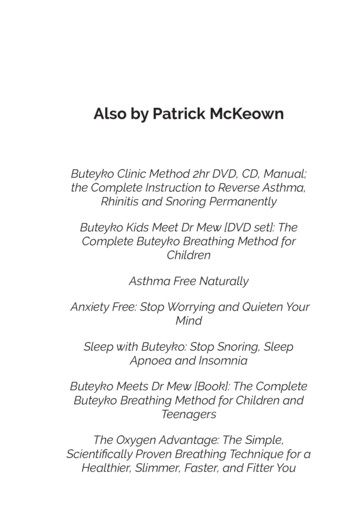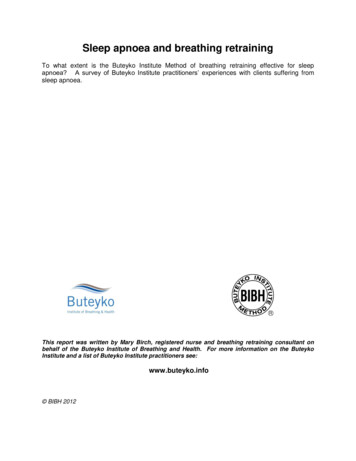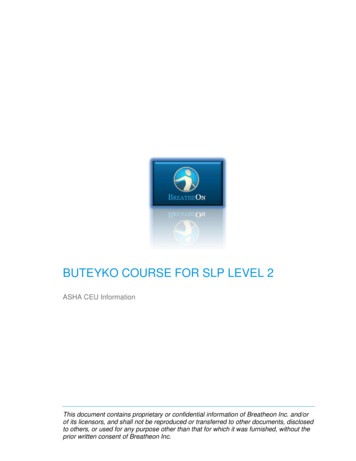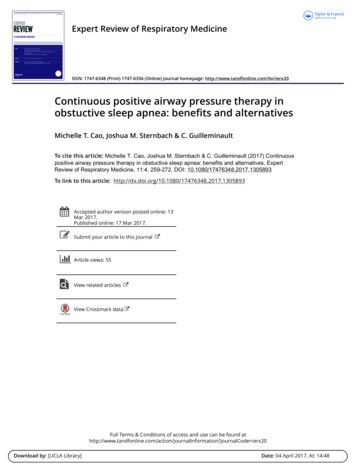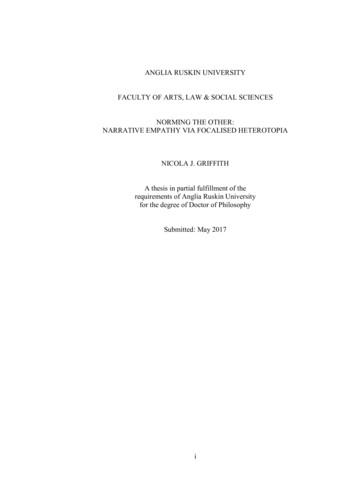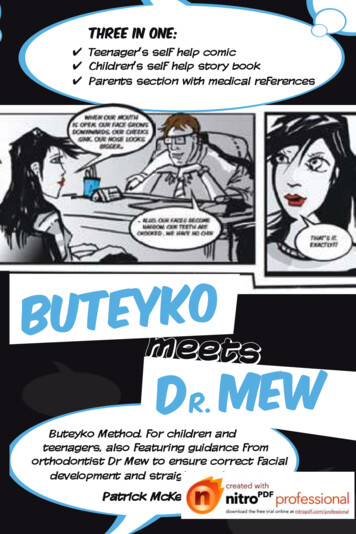
Transcription
Three in one: Teenager’s self help comic Children’s self help story book Parents section with medical referencesButeymkoeetsDr. MewButeyko Method. for children andteenagers, also featuring guidance fromorthodontist Dr Mew to ensure correct facialdevelopment and straight teeth.Patrick McKeown
Buteyko Meets Dr MewPatrick McKeownButeykoClinic.comButeykoKids.com
Patrick McKeownButeykoClinic.comImprint of Asthma CareButeyko meets Dr MewPublished by: ButeykoClinic.com Imprint of Asthma Care Loughwell, Moycullen, Co GalwayWeb: www.ButeykoClinic.com Email: info@buteykoclinic.com Patrick McKeown 2010Illustrations by Timm JoyThe information contained in this book is not intended to serve as a replacement for professional medical advice. Any use of the information in this book is at the reader’s discretion. The author and the publisher specifically disclaim any and all liability arising directly or indirectly from the use or application of any information contained in this book. A health care professional should be consulted regarding your specific situation.All rights reserved.
Be who you are and say what you feel, because those who mind don’t matter and those who matter don’t mind. — Dr. eussiii
Table of ContentsBook One—Especially for Teens 1Meet Dr Mew . 2Grow the Perfect Face . 5Who Wants Crooked Teeth? . 6Unblock the Nose . 8Tiger the Cat . 11Good Sports Performance . 13Oxygenate Your Brain . 15Don’t Look Dumb . 17Look Good, Feel Good . 19Book Two — Especially for Parents 21What Is Good Breathing? . 23Who is Dr Buteyko? 27 Overbreathing 29 How to recognise habitual overbreathing 30How Should We Breathe? . 31Carbon dioxide 32 Bohr Effect simply explained 34 Improve oxygenation 37 Symptoms of chronic hyperventilation 38 How might it apply to your child? 39Growing The Perfect Face . 43Who is Dr Mew? 45 Dr Mew’s patients 46 Evolution of crooked teeth 49 Diet and mouth breathing 50 The big teethed mule 52 Mouth breathing causes crooked teeth 54 Every child has the potential to grow an attractive face 55 How children develop crooked teeth 57 Craniofacial abnormalities 63 Reversible at an early age 67 Orthodontics: choose wisely 69 Identical twins 71 Sixty Minutes TV interview 74
Everything To Correct Breathing . 78Note of caution 79 Unblock the nose 81 Step it up! 84 Reduced breathing 88 Approach one – blocking one nostril 90 Approach two—hand over face 92 Approach three – Ryan hides his breathing 94 Correct tongue posture 96 Correct swallow 99 How to stop cough and wheeze 101Lifestyle 105Snoring and sleep apnoea 106 Mouth breathing and diet 113Especially For Infants 115What To Do Going Forward 121Conclusion 125Appendices & References 131vi
Book Three—Especially for ChildrenMeet Cían .138Summer sports Day in Tumbletown . 139Cían meets Argo the wizard .140ABC Game.141How to unblock your nose . 143What is our nose for? .144Argo lets Cían in on a secret . 145Finding the correct “spot” . 147Walk the steps .150What causes wheezing and coughing .153Avoiding triggers .155The secret to breathe correctly .156The big race .157The Winner .161My Step Diary . 165vii
forewordAs a small child I was constantly berated if I did not ‘Stand up Straight’ and ‘Keep My Mouth Shut’ and at school the headmaster had a plywood cut out of a camel which was pointed at any child who sat with their back bent. Nowadays few children suffer this ignominy but the ratio of four year olds that spend the majority of the time with their mouths open, exceeds eighty percent.Few parents realise the true extent that their child’s health can be damaged by such simple factors. As a surgeon it used to upset me to realise that just for the lack of this knowledge many attractive kids would grow up with plain faces and chronic health problems.Patrick McKeown is doing his best to redress this in his colourful and tactful way and I would like to give him every encouragement. My orthodontic education was both strict and restrictive; extractions were considered inevitable and the possibilities of changing the growth of the face very limited. It was many years later that I discovered that much can be done by both treatment and especially persuasion to encourage children to create their own future. Dr John Mew, orthodontist ix
BOOK ONEESPECIALLY FOR TEENSButeykoTeens Learn the Secret1
2
3
4
5
6
7
8
9
10
11
12
13
14
15
16
17
18
19
StepsRecord est for one minute between each repetition of steps. Photocopy this page and start recording your progress. Rest for one minute between each repetition of steps. Two rows of steps per day wo rows of steps per day with at least two hours rest in with at least two hours rest in between each line. Steps should be between each line. teps should be practised on an empty practised on an empty tummy.20tummy.
BOOK TWOESPECIALLY FOR PARENTS21
WHAT IS GOOD BREATHING?23
Ancient Chinese philosopher Lao Tzu once said that “The perfect man breathes as if he does not breathe.” In order to live, the three ingredients of water, food and air are vital but which is more important? We can live without food for weeks, and without water for days but we can live without air for just a few moments. If we measure the importance of each element by how long we can live without it, air becomes so much more important than either food or water.We all know the importance of good air quality. Smog, pollution or inferior air has a negative impact to our health. But what about the quantity of air? It is not common knowledge but breathing a large volume of air can also be detrimental to our health. Silence is a sign of good breathing, i.e. when the mouth is closed and our air exchange (breathing in and out) is silent during a period of rest. Good breathing is regular and calm without sighs or sniffs. Good breathing is when we cannot see or hear it. It is unnoticeable. This is what Lao Tzu meant when he said “the perfect man breathes as if he does not breathe.” When the body is efficient, breathing is quiet. On the other hand, inefficient breathing is noisy, heavy, loud, and erratic. It takes effort, but breathing should not be an effort. When breathing is done through the mouth more air is taken in but less oxygen is delivered throughout the body. This might be counter to 24
what you believe, but when you understand how oxygen is delivered from the blood it will make sense. Pale faces, black circles under the eyes, stuffy noses, asthma, snoring, behavioural problems, poor concentration, craniofacial abnormalities are all significantly affected by poor breathing habits. Each year, I see the breathing habits of children and teenagers throughout Europe and the USA. Many attend my courses because they are wheezing or coughing. Others come for help with sports, to improve their performance and fitness. Others come because they have been referred by their dentist who is only too aware of the problems associated with mouth breathing. They all have one thing in common — they have learned the bad habit of heavy breathing. Their breathing is often through the mouth and is noisy with regular sighs and yawns. But the good news is that it can be easily addressed as soon as the child or teenager is aware of it. All it takes is a little commitment and discipline. The rewards are a better looking child with correct craniofacial development and better health. Incorporating the work of Dr Buteyko and Dr Mew is instrumental to improving every child and teenagers health.25
26
WHO IS DR BUTEYKO?The Buteyko Method was developed in the 1950’s by Russian doctor Konstantin Buteyko. His method has been practised by hundreds of thousands of children and adults for a variety of conditions including mouth breathing, hay fever, blocked nose, snoring, sleep apnoea, asthma, blood pressure, anxiety, stress, panic attacks and depression. As a young doctor, Buteyko spent many months sitting at sick patients’ bedsides observing their states of health. He noticed that each person’s breathing got heavier as his or her health deteriorated. As their illnesses advanced, he saw that his patients breathing movements from their chests and tummies increased, that their breathing became more audible, that their breaths became faster and that they sighed more and breathed through their mouths. In time, he was able to predict the onset of death just by observing their breathing.This raised a fundamental question for Buteyko: was it his patients’ sickness that contributed to their heavy breathing or was it their heavy breathing that contributed to their sickness?27
At the time, Buteyko suffered from severe hypertension that was going from bad to worse. He began experimenting by breathing less and quieting his breathing. Within a short while, the pains that he had experienced for months went away.Over the following decades, Buteyko extensively researched this subject and had a dedicated laboratory to further his fi ndings. His method was brought to the West in 1990 and is now taught in many countries. Breathing, such a vital factor for life, must meet certain conditions. Severe overbreathing can be fatal if sustained over a short period. Therefore, it is plausible to accept that negative health effects will result from less severe but still excessive breathing over a long period.28
OVERBREATHINGChronic overbreathing basically means that we habitually breathe more air than what our bodies require. In many ways, this is similar to a person developing the habit of overeating. Breathing is similar. If we breathe more than what our bodies require over a 24-hour period, the habit takes hold. Dr Stephen Demeter confirms this when he states, “Prolonged hyperventilation (for more than 24 hours) seems to sensitize the brain, leading to a more prolonged hyperventilation.”1What increases breathing volume?Breathing increases as a result of modern living. Factors such as strong emotions, tension, anger, stress, overeating, processed foods, a belief that taking big breaths is good, lack of exercise, excessive talking and high temperatures within the home all contribute to overbreathing.29
HOW TO RECOGNISE HABITUALOVERBREATHINGAt this point, you might think that your child does not overbreathe. For most children, overbreathing is subtle. It is hidden, which is why it often goes undetected. The typical characteristics attending my clinics include: Breathing through the mouth; Audible breathing during rest; Regular sighs; Regular sniffing; Irregular breathing; Holding of the breath (apnoea); Taking large breaths prior to talking; Yawning with big breaths; Upper chest movement; Movement of shoulders while breathing; Lot of visible movement; Effortful breathing; Heavy breathing at night.How many apply to your child? Does your child sigh? Does your child breathe through their mouth? Do they wake up with a dry mouth in the morning?30
HOW SHOULD WE BREATHE?31
CARBON DIOXIDECarbon dioxide or CO2 is a gas created from our metabolic process as an end product. The human lungs require 5% CO2 or 40 mmHg. If we breathe too heavily, CO2 is exhaled or washed from our lungs. A loss of CO2 from the lungs results in a reduction of CO2 in the blood, tissues and cells.The release of oxygen from red blood cells depends on the partial pressure or quantity of carbon dioxide in your lungs/arterial blood. When one is overbreathing, carbon dioxide is removed from the body, causing the oxygen to “stick” to haemoglobin within the red blood cells. This prevents its release into tissues and organs. This bond, discovered in 1904, is known as the Bohr Effect.It is worth noting that during normal conditions, 75% of your intake of oxygen is exhaled while breathing a healthy volume of four to six litres per minute. Even during inte
orthodontist Dr Mew to ensure correct facial development and straight teeth. Patrick McKeown Dr.Mew meets Three in one: Teenager’s self help comic Children’s self help story book Parents section with medical references “Without doubt, children and teenagers who mouth or overbreathe are at a distinct disadvantage in terms of breathing, facial appearance, sleep quality and academic .
